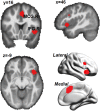Large-scale functional neural network correlates of response inhibition: an fMRI meta-analysis
- PMID: 28551777
- PMCID: PMC5686258
- DOI: 10.1007/s00429-017-1443-x
Large-scale functional neural network correlates of response inhibition: an fMRI meta-analysis
Abstract
An influential hypothesis from the last decade proposed that regions within the right inferior frontal cortex of the human brain were dedicated to supporting response inhibition. There is growing evidence, however, to support an alternative model, which proposes that neural areas associated with specific inhibitory control tasks co-exist as common network mechanisms, supporting diverse cognitive processes. This meta-analysis of 225 studies comprising 323 experiments examined the common and distinct neural correlates of cognitive processes for response inhibition, namely interference resolution, action withholding, and action cancellation. Activation coordinates for each subcategory were extracted using multilevel kernel density analysis (MKDA). The extracted activity patterns were then mapped onto the brain functional network atlas to derive the common (i.e., process-general) and distinct (i.e., domain-oriented) neural network correlates of these processes. Independent of the task types, activation of the right hemispheric regions (inferior frontal gyrus, insula, median cingulate, and paracingulate gyri) and superior parietal gyrus was common across the cognitive processes studied. Mapping the activation patterns to a brain functional network atlas revealed that the fronto-parietal and ventral attention networks were the core neural systems that were commonly engaged in different processes of response inhibition. Subtraction analyses elucidated the distinct neural substrates of interference resolution, action withholding, and action cancellation, revealing stronger activation in the ventral attention network for interference resolution than action inhibition. On the other hand, action withholding/cancellation primarily engaged the fronto-striatal circuit. Overall, our results suggest that response inhibition is a multidimensional cognitive process involving multiple neural regions and networks for coordinating optimal performance. This finding has significant implications for the understanding and assessment of response inhibition.
Keywords: Action restrain; Interference resolution; Meta-analysis; Multilevel kernel density analysis; fMRI.
Figures






References
-
- Apicella P, Scarnati E, Ljungberg T, Schultz W. Neuronal activity in monkey striatum related to the expectation of predictable environmental events. J Neurophysiol. 1992;68(3):945–960. - PubMed
-
- Aron AR. The neural basis of inhibition in cognitive control. Neuroscientist. 2007;13(3):214–228. - PubMed
-
- Aron AR, Fletcher PC, Bullmore ET, Sahakian BJ, Robbins TW. Stop-signal inhibition disrupted by damage to right inferior frontal gyrus in humans. Nat Neurosci. 2003;6(2):115–116. - PubMed
Publication types
MeSH terms
Substances
Grants and funding
LinkOut - more resources
Full Text Sources
Other Literature Sources
Medical

